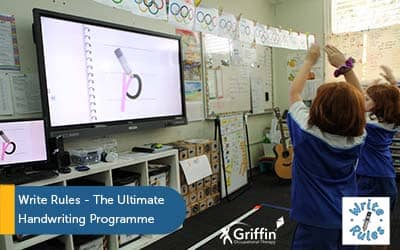Understanding the writing framework
The Department for Education’s new Writing Framework provides comprehensive guidance for teaching writing from Reception through Year 6, offering a research-informed approach that aligns with both national curriculum requirements and Ofsted expectations.
Key points: the writing framework
1. The writing framework provides guidance on teaching transcription and composition skills to primary school children. The guidance is for Reception and Key Stage 1 and 2 students.
2. The first part provides clear guidance on how to teach writing transcription skills, including explicit handwriting lessons in reception in letter formation families such as those recommended in Write Rules. If you are a reception teacher, Kim explores specific tips for implementing the writing framework in reception here.
3. There second part of the guidance provides wider recommendations to help children with their spelling and composition skills. These align with the current national curriculum and early years framework.
Understanding the writing framework
The Department for Education’s new Writing Framework provides comprehensive guidance for teaching writing from Reception through Year 6, offering a research-informed approach that aligns with both national curriculum requirements and Ofsted expectations.
Key points: the writing framework
1. The writing framework provides guidance on teaching transcription and composition skills to primary school children. The guidance is for Reception and Key Stage 1 and 2 students.
2. The first part provides clear guidance on how to teach writing transcription skills, including explicit handwriting lessons in reception in letter formation families such as those recommended in Write Rules. If you are a reception teacher, Kim explores specific tips for implementing the writing framework in reception here.
3. There second part of the guidance provides wider recommendations to help children with their spelling and composition skills. These align with the current national curriculum and early years framework.

Department for Education’s new Writing Framework
The Department for Education’s new Writing Framework (July 2025) offers teachers a comprehensive, evidence-based roadmap for developing confident, capable writers from Reception through Year 6. This framework moves beyond generic advice to provide specific, practical strategies that align with national curriculum requirements and Ofsted expectations. The guidance recognizes that writing success depends on systematic, well-sequenced instruction that builds both technical skills and creative confidence. This framework provides evidence-based guidance to help teachers develop confident, capable writers who can succeed across their academic journey and beyond. It is broken into eight sections, each of which is outlined below.
Writing framework Section 1: Understanding Writing Development
Writing success depends on two interconnected components: transcription (the physical act of handwriting and spelling) and composition (generating and organizing ideas). The framework emphasises that while strong oral language provides the foundation, children need explicit, systematic teaching to become proficient writers.
Crucially, writing places significant cognitive demands on young learners. When transcription skills become automatic, children can dedicate more mental energy to crafting their ideas and expressing themselves clearly.
Section 2: Foundation Skills in Reception
Reception year establishes critical building blocks for future writing success. Kim explores implementation of the writing programme in reception in more depth in this article. In summary, teaching should build essential skills including oral composition, basic handwriting, phonics for spelling. Rather than focusing on lengthy pieces, prioritise:
- Explicit daily handwriting instruction which is separate to phonics teaching, such as the lessons in GriffinOT’s Write Rules scheme of work
- Quality letter formation with proper posture and grip
- Oral sentence composition before writing begins
- Physical development activities to strengthen gross and fine motor skills
- Regular dictation to practice transcription skills
The framework emphasises simple, frequent practice rather than long texts early on. The focus of handwriting lessons should be on accuracy and foundation-building rather than quantity of output. Write Rules supports schools to successfully teach children these foundation skills and much more.

Writing Framework Section 3: Developing Transcription Skills
Handwriting requires systematic, daily instruction which focuses on:
- Correct posture and pencil grip – Crocodile Snap helps children to learn which fingers to hold their pencil with
- Accurate letter formation and appropriate spacing – The Write Rules songs help children to learn their letter formations in a fun and easy way
- Progression to joined writing only after print letters are secure
Spelling instruction should follow a structured sequence:
- Begin with systematic phonics – you will already be doing this as part of the of your phonics lessons
- Gradually incorporate orthographic patterns, morphology, and etymology
- Use dictation exercises to apply spelling in context
- Implement low stakes testing to monitor progress
The guidance recommends that formal typing instruction can be introduced in upper Key Stage 2, ensuring handwriting fluency is established first. However, for children with significant transcription difficulties, it may be worth considering an early transition to typing especially if this supports their motivation to write.
Section 4: Building Composition Skills
Effective composition teaching centres on sentence construction as the fundamental building block. Key strategies include:
- Oral rehearsal of sentences before writing, especially in early stages
- Model texts to expose pupils to varied sentence structures and sophisticated language
- Teach sentence-level mastery first, then paragraph and full-text structure
- Integrate grammar, punctuation, and vocabulary in context
- Vocabulary development through rich, varied language exposure
- Use the full writing process: planning → drafting → revising → editing → sharing, with clear audience/purpose
- Help pupils understand how audience and purpose shape their writing choices, and provide timely, constructive feedback that focuses on specific improvements.
Section 5: Supporting All Learners
Maintain high expectations for every pupil while providing targeted support for those who need it most:
- Early identification of writing barriers through careful classroom observation
- Smaller learning steps with increased practise opportunities – Write Rules can be used with smaller groups to support those who need extra help with transcription skills
- Specialist consultation with SENCOs and other professionals, such as occupational therapists to support transcription or speech and language therapists to support language skills when needed
- Adaptive approaches that maintain curriculum access for pupils with complex needs
GriffinOT’s handwriting scheme of work Write Rules can help you to easily implement the writing framework guidelines across your school.
Section 6 Writing Framework: Writing Across the Curriculum
Integrate writing meaningfully with other subjects to:
- Leverage pupils’ subject knowledge in their writing
- Demonstrate writing as a tool for thinking and learning
- Provide authentic contexts for different text types
- Prepare pupils for secondary school writing demands
- Ensure writing tasks enhance rather than overshadow the primary learning objectives in other subjects.
Writing Framework Section 7: Implementation and Leadership
Successful writing instruction requires strong leadership that:
- Establishes a positive whole-school writing culture
- Ensures well-sequenced curriculum delivery
- Provides ongoing professional development for teachers
- Implements effective assessment strategies
- Designates literacy leadership expertise
Section 8: Assessment Context
The framework acknowledges current national assessment requirements including the Early Years Foundation Stage Profile, Phonics Screening Check, and Key Stage 1 and 2 assessments, ensuring teaching approaches support both learning and assessment success.
Supporting writing framework implementation with Write Rules
I know this might sound like a lot to implement, but it is likely your existing school curriculum covers a lot of the guidance already. If you need help to meet the writing framework guidance on transcription we are here to help. Our handwriting scheme of work Write Rules already covers everything the framework recommends – and more! Write Rules
✅ Teaches letters in developmentally appropriate letter family groups
✅ Includes daily ‘ready to write’ activities (Move with Jessie, Dough Dance, Crocodile Challenges)
✅ Provides explicit, systematic handwriting instruction
✅ Helps you tick every box on their reception, handwriting and handwriting progression checklists – here’s how
✅ Supports teachers and teaching assistants with to increase their knowledge on fine motor skills and handwriting with our training.
✅ Includes access to our monthly Ask Kim sessions where staff can have extra guidance from an occupational therapist
You can learn more about Write Rules here.
Date last updated by Kim: 28th September 2025



